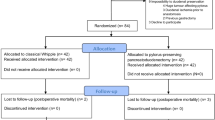Abstract
Preservation of the pylorus at the time of pancreaticoduodenectomy has been associated with equal oncological outcomes when compared to the classical Whipple operation. Multiple studies have demonstrated that pylorus-preserving pancreaticoduodenectomy (PPPD) has equal or superior outcomes regarding quality of life when compared with the traditional Whipple operation, but many studies have suggested a higher incidence of delayed gastric emptying (DGE). DGE prolongs hospital stay, and its association with PPPD has hampered its adoption by many pancreatic surgery centers. We describe a novel surgical technique for the prevention of delayed gastric emptying following pylorus-preserving pancreaticoduodenectomy. The technique of pyloric dilatation appears to decrease the incidence of delayed gastric emptying and facilitates earlier hospital discharge, when compared with standard pylorus preserving pancreaticoduodenectomy.
Similar content being viewed by others
References
Souba WW. Glutamine: a key substrate for the splanchnic bed. Annu Rev Nutr 1991;11:285–308.
Zapata-Sirvent RL, Hansbrough JF, Ohara MM, Rice-Asaro M, Nyhan WL. Bacterial translocation in burned mice after administration of various diets including fiber- and glutamine-enriched enteral formulas. Crit Care Med 1994;22:690–696.
Gianotti L, Alexander JW, Gennari R, Pyles T, Babcock GF. Oral glutamine decreases bacterial translocation and improves survival in experimental gut-origin sepsis. JPEN J Parenter Enteral Nutr 1995;19:69–74.
Ikeda S, Zarzaur BL, Johnson CD, Fukatsu K, Kudsk KA. Total parenteral nutrition supplementation with glutamine improves survival after gut ischemia/reperfusion. JPEN J Parenter Enteral Nutr 2002;26:169–173.
Khogali SE, Harper AA, Lyall JA, Rennie MJ. Effects of L-glutamine on post-ischaemic cardiac function: protection and rescue. J Mol Cell Cardiol 1998;30:819–827.
Wischmeyer PE, Van den Hoek TL, Li C, et al. Glutamine preserves cardiomyocyte viability and enhances recovery of contractile function after ischemia-reperfusion injury. JPEN J Parenter Enteral Nutr 2003;27:116–122.
Wischmeyer PE, Musch MW, Madonna MB, Thisted R, Chang EB. Glutamine protects intestinal epithelial cells: role of inducible HSP70. Am J Physiol 1997;272:G879-G884.
Hayashi Y, Sawa Y, Fukuyama N, Nakazawa H, Matsuda H. Preoperative glutamine administration induces heat-shock protein 70 expression and attenuates cardiopulmonary bypass-induced inflammatory response by regulating nitric oxide synthase activity. Circulation 2002;106:2601–2607.
Ryan AJ, Flanagan SW, Moseley PL, Gisolfi CV. Acute heat stress protects rats against endotoxin shock. J Appl Physiol 1992;73:1517–1522.
Villar J, EdelsonJD, PostM, Mullen JB, Slutsky AS. Induction of heat stress proteins is associated with decreased mortality in an animal model of acute lung injury. Am Rev Respir Dis 1993; 147:177–181.
Perdrizet GA, Kaneko H, Buckley TM, et al. Heat shock and recovery protects renal allografts from warm ischemic injury and enhances HSP72 production. Transplant Proc 1993;25:1670–1673.
Perdrizet GA, Rewinski MJ, Schweizer RT, Scharp DW. Heat shock and recovery protects pancreatic islets from warm ischemic injury. Transplant Proc 1994;26:3477–3478.
Mestril R, Chi SH, Sayen MR, O’Reilly K, Dillmann WH. Expression of inducible stress protein 70 in rat heart myogenic cells confers protection against simulated ischemia-induced injury. J Clin Invest 1994;93:759–767.
Saad S, Kanai M, Awane M, et al. Protective effect of heat shock pretreatment with heat shock protein induction before hepatic warm ischemic injury caused by Pringle’s maneuver. Surgery 1995;118:510–516.
Kume M, Yamamoto Y, Saad S, et al. Ischemic preconditioning of the liver in rats: implications of heat shock protein induction to increase tolerance of ischemia-reperfusion injury. J Lab Clin Med 1996;128:251–258.
Suh GJ, Youn YK, Song HG, Rhee JE, Jung SE. The effect of glutamine in inducible nitric oxide synthase gene expression in intestinal ischemia-reperfusion injury. Nutr Res 2003;23:131–140.
Basoglu M, Yildirgan I, Akcay F, Kiziltunc A, Kavak I, Oren D. Glutathione and nitric oxide concentrations in glutamine-infused rabbits with intestinal ischaemia/reperfusion. Eur J Clin Chem Clin Biochem 1997;35:415–419.
Prem JT, Eppinger M, Lemmon G, Miller S, Nolan D, Peoples J. The role of glutamine in skeletal muscle ischemia/reperfusion injury in the rat hind limb model. AmJ Surg 1999;178:147–150.
Wischmeyer PE, Kahana M, Wolfson R, Ren H, Musch MM, Chang EB. Glutamine induces heat shock protein and protects against endotoxin shock in the rat. J Appl Physiol 2001;90:2403–2410.
Milne KJ, Noble EG. Exercise-induced elevation of HSP70 is intensity dependent. J Appl Physiol 2002;93:561–568.
Tazuke Y, Wasa M, Shimizu Y, Wang HS, Okada A. Alanylglutamine-supplemented parenteral nutrition prevents intestinal ischemia-reperfusion injury in rats. JPEN J Parenter Enteral Nutr 2003;27:110–115.
Fukatsu K, Ueno C, Hashiguchi Y, et al. Glutamine infusion during ischemia is detrimental in a murine gut ischemia/reperfusion model. JPEN J Parenter Enteral Nutr 2003 ;2 7:187–192.
Clavien PA, Selzner M, Rudiger HA, et al. A prospective randomized study in 100 consecutive patients undergoing major liver resection with versus without ischemic preconditioning. Ann Surg 2003;238:843–850.
Kawano K, Kim YI, Goto S, et al. Evidence that azathioprine, as well as cyclosporine, ameliorates warm ischemia in the rat liver. Transplantation 1990;49:1002–1003.
Sakr MF, Zetti GM, Farghali H, et al. Protective effect of FK 506 against hepatic ischemia in rats. Transplant Proc 1991;23:340–341.
Fabia R, Travis DL, Levy MF, Husberg BS, Goldstein RM, Klintmalm GB. Effect of pentoxifylline on hepatic ischemia and reperfusion injury. Surgery 1997;121:520–525.
Araya J, Tsuruma T, Hirata K, Yagihashi A, Watanabe N. TCV-116, an angiotensin II type 1 receptor antagonist, reduces hepatic ischemia-reperfusion injury in rats. Transplantation 2002;73:529–534.
Author information
Authors and Affiliations
Corresponding author
Rights and permissions
About this article
Cite this article
Fischer, C.P., Hong, J.C. Method of pyloric reconstruction and impact upon delayed gastric emptying and hospital stay after pylorus-preserving pancreaticoduodenectomy. J Gastrointest Surg 10, 215–219 (2006). https://doi.org/10.1016/j.gassur.2005.07.017
Issue Date:
DOI: https://doi.org/10.1016/j.gassur.2005.07.017




